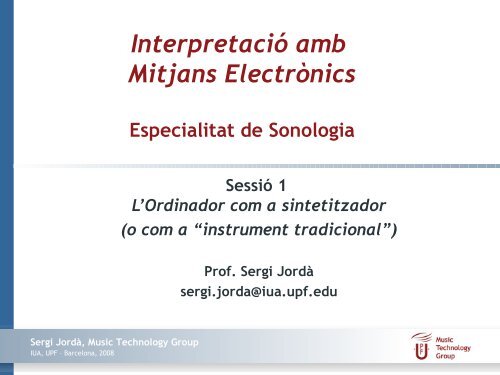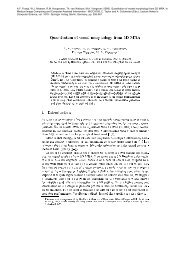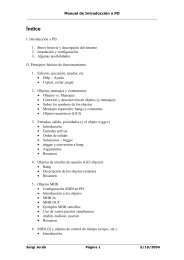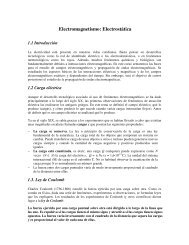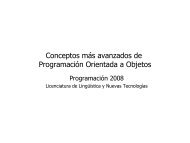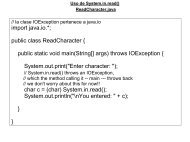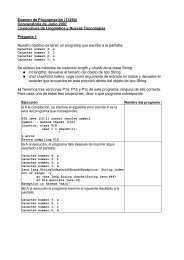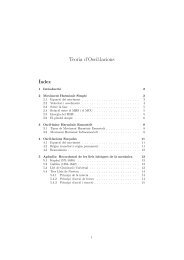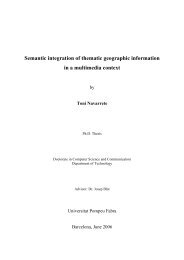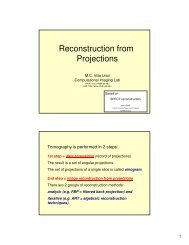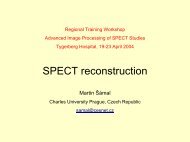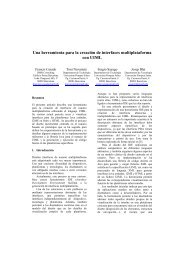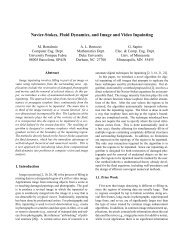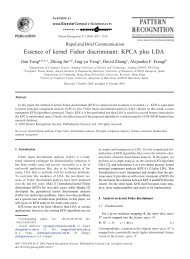QWERTY Caster - Universitat Pompeu Fabra
QWERTY Caster - Universitat Pompeu Fabra
QWERTY Caster - Universitat Pompeu Fabra
You also want an ePaper? Increase the reach of your titles
YUMPU automatically turns print PDFs into web optimized ePapers that Google loves.
Interpretació amb<br />
Mitjans Electrònics<br />
Especialitat de Sonologia<br />
Sessió 1<br />
L’Ordinador com a sintetitzador<br />
(o com a “instrument tradicional”)<br />
Prof. Sergi Jordà<br />
sergi.jorda@iua.upf.edu<br />
Sergi Jordà, Music Technology Group<br />
IUA, UPF – Barcelona, 2008
Part I: Digital vs. Acoustic Instruments<br />
Sergi Jordà, Music Technology Group<br />
IUA, UPF – Barcelona, 2008
Traditional Music Instruments / Construction<br />
Most acoustic instruments consist of<br />
an excitation source that can oscillate in different<br />
ways under the control of the performer<br />
a resonating system that couples the vibrations of<br />
the oscillator to the surrounding air<br />
Parts of the performer’s body generate the energy for<br />
the excitation of the instrument, interacting through<br />
the instrument’s control interface<br />
Sergi Jordà, Music Technology Group<br />
IUA, UPF – Barcelona, 2008
Traditional Music Instruments / Restrictions<br />
1. Limited by physical constraints<br />
2. Restricted control of their output<br />
3. Human excitation energy dependent (in acoustic instr.)<br />
4. Human control dependent<br />
Sergi Jordà, Music Technology Group<br />
IUA, UPF – Barcelona, 2008
Traditional Music Instruments / Restrictions<br />
<br />
<br />
<br />
<br />
The possibilities & limitations of acoustic instruments concerning<br />
both mechanical inputs & control, and sonic output, are hardwired<br />
by physical constraints. Acoustic instruments tend to impose by<br />
construction their own playability rules, which allow listeners to<br />
infer the type and form of the gesture from the generated sound<br />
No instrument allows for a complete control over its whole sonic<br />
richness. Microevolutions of their parameters are often<br />
uncontrollable and subject to a combination of (a) complex<br />
correlations (b) structural and morphological constraints and (c)<br />
additional random -or ungraspable- factors<br />
With few exceptions (as it is the case of the organs) the excitation<br />
energy needed for the instrument to sound has to be provided by<br />
the performer (blown, struck, plucked or rubbed)<br />
With few exceptions, not only energy but also all type of temporal<br />
control variations or modulations of parameters (e.g. vibrato or<br />
tremolo) have to be explicitly and permanently addressed<br />
physically by the performer<br />
Sergi Jordà, Music Technology Group<br />
IUA, UPF – Barcelona, 2008
Gesture Types in Music Making<br />
Selection<br />
Finger on a fret, selecting a soundbank …<br />
They are previous to sound production<br />
Decision<br />
Fretting a string, hitting a key …<br />
They bring the energy<br />
They make a sound with instant parameters<br />
Modulation<br />
Moving a pedal, a mod. wheel<br />
Changes sound parameters over time<br />
Sergi Jordà, Music Technology Group<br />
IUA, UPF – Barcelona, 2008
Digital Music Instruments<br />
Controller/Generator clearly separated (exchangeable?)<br />
Inputs<br />
no clear distinction between excitation and control<br />
everything is possible (??)<br />
blow, strike, pluck, rub, bow … +<br />
click, double-click, type, point, slide, twirl, drag<br />
and drop … +<br />
?????? (we will study sensors in another Module)<br />
Outputs: everything is possible (??)<br />
Sergi Jordà, Music Technology Group<br />
IUA, UPF – Barcelona, 2008
Outputs: everything is possible (??)<br />
<br />
<br />
<br />
<br />
Any parameter variation can now be implemented as desired;<br />
continuously, discreetly, or as a combination of both<br />
Timbre does not have to be left out anymore. Any imaginable<br />
timbre can be rendered theoretically; it can change abruptly or<br />
evolve continuously, and even smooth transitions between any set<br />
of distinct timbres can be achieved (e.g. Grey 1975; Wessel 1979;<br />
Wessel et al. 1998)<br />
Small periodic changes can still be applied to anything, with<br />
unlimited and precise control over all of the oscillation parameters<br />
(frequency, amplitude and shape of the oscillation), and these<br />
modulations do not have to be permanently addressed by the<br />
performer anymore since separate threads in the machine are<br />
taking charge of them<br />
The performer, who no longer needs to control all the smaller<br />
details, can control instead the processes that control these details<br />
Sergi Jordà, Music Technology Group<br />
IUA, UPF – Barcelona, 2008
AUTOMATED CONTROL<br />
PROCESSES<br />
Hammond+Leslie<br />
Analog modular<br />
synthesizer<br />
NON-HUMAN<br />
EXCITATION<br />
ENERGY<br />
Sergi Jordà, Music Technology Group<br />
IUA, UPF – Barcelona, 2008
From the “do-everything-yourself”<br />
to the “one-button-does-it-all”<br />
We will start by studying the left<br />
paradigm, i.e. when computers<br />
behave like traditional instruments,<br />
leaving everything to the musician<br />
responsibility…<br />
Sergi Jordà, Music Technology Group<br />
IUA, UPF – Barcelona, 2008
Sergi Jordà, Music Technology Group<br />
IUA, UPF – Barcelona, 2008<br />
Part II: Music Controllers
Traditional Music Instruments restrictions /<br />
Revisited<br />
Limited by physical constraints<br />
Restricted control of their output<br />
Human excitation energy dependent (in acoustic instr.)<br />
Human control dependent<br />
Even when we want to remain closer to the “acoustic<br />
instrument model”, point 1 does not make much sense<br />
(unless we want to make digital clones of acoustic<br />
instruments), and point 3 is not easy to achieve<br />
Sergi Jordà, Music Technology Group<br />
IUA, UPF – Barcelona, 2008
Controllers’ Summary (1/2) THE EASY SIDE<br />
(from Jordà 2007)<br />
Music controllers can preserve traditional playing<br />
modes, permitting us to blow, strike, pluck, rub or bow<br />
our ‘computers’; new traditionalists in turn, may<br />
prefer to continue clicking, double-clicking, typing,<br />
pointing, sliding, twirling or dragging and dropping<br />
them. The decision is up to everyone. With the<br />
appropriate sensors, new digital instruments can also<br />
be caressed, squeezed, kissed, licked, danced, hummed<br />
or sung. They can even disappear or dematerialise<br />
while responding to our movements, our muscle tension<br />
or our facial expressions.<br />
Sergi Jordà, Music Technology Group<br />
IUA, UPF – Barcelona, 2008
Controllers’ Summary (2/2) DIFFICULT SIDE!!!<br />
(from Jordà 2007)<br />
With the flexibility offered by MIDI, any controller can certainly be combined with<br />
any sound- and music-producing device. Still, each choice is critical. As pointed<br />
out by Joel Ryan, improviser, leading researcher in the NIME field and technical<br />
director of the Dutch laboratory STEIM, ‘a horizontal slider, a rotary knob, a<br />
sensor that measures the pressure under one finger, an accelerometer which can<br />
measure tilt and respond to rapid movements, a sonar or an infrared system that<br />
can detect the distance between two points, each have their idiosyncratic<br />
properties’ (Ryan 1991).<br />
Any input device can become a good or a bad choice depending on the context,<br />
the parameter to control, or the performer who will be using it. Just as the<br />
automotive engineer chooses a steering wheel over left/right incrementing<br />
buttons, ‘we should not hand a musician a butterfly net when a pitchfork is<br />
required’ (Puckette and Settel 1993). The challenge remains how to integrate and<br />
transform this apparatus into coherently designed, meaningful musical<br />
experiences with emotional depth.<br />
It is in fact extremely hard to design highly sophisticated control interfaces<br />
without a profound prior knowledge of how the sound or music generators will<br />
proceed; a parallel design process will surely be more enriching than buying the<br />
ultimate controller for plugging into any custom software.<br />
Sergi Jordà, Music Technology Group<br />
IUA, UPF – Barcelona, 2008
Interaction Coherence ?<br />
The disappearance of physical constraints, should be<br />
replaced with deep musical, metaphorical, ergonomic …<br />
coherence<br />
Seeking coherence is somewhat in the antipodes of the Theremin<br />
limited success, which is best known for its “magic” way of playing<br />
Sergi Jordà, Music Technology Group<br />
IUA, UPF – Barcelona, 2008
In Common?<br />
Sergi Jordà, Music Technology Group<br />
IUA, UPF – Barcelona, 2008
Timbre navigation<br />
The voice, the didgeridoo, brass with cups….<br />
Not many acoustic instruments allow for a continuous<br />
modification/transformation of their resonant bodies…<br />
Not many acoustic instruments allow thus for continuous<br />
and (reasonable uncorrelated) timbre navigation<br />
Continuous timbre navigation (more than an infinite<br />
timbre palette) is arguably one of the assets of<br />
“traditional” computer based music instruments<br />
Sergi Jordà, Music Technology Group<br />
IUA, UPF – Barcelona, 2008
Music Controllers / Prehistory<br />
Except perhaps for keyboards, the concept of music<br />
controller is alien to acoustic music instruments<br />
The theremin, one of the first and still more famous,<br />
electronic instruments (famous because of the way it is<br />
played -- i.e. without touching it), is a full instrument,<br />
not a controller<br />
Clara Rockmore performs Saint-Saëns’ "The Swan"<br />
Canadian musician and researcher Hugh LeCaine, was<br />
between 1940s-70s a pioneer in the field of electric and<br />
electronic instruments<br />
electronic sackbut (1945-73)<br />
Sergi Jordà, Music Technology Group<br />
IUA, UPF – Barcelona, 2008
Hugh Le Caine’s electronic sackbut (1945-1973)<br />
Sergi Jordà, Music Technology Group<br />
IUA, UPF – Barcelona, 2008
Hugh Le Caine’s electronic sackbut<br />
Musical examples<br />
1948 “clarinet” (Rapshody in Blue)<br />
1948 “mutted trombone” (playing with formants)<br />
1948 “brass to clarinet” (Blues)<br />
1948 “strings”<br />
Bill Farrow plays “brass-like”<br />
Mal Clark plays “brass-like”<br />
From “Hugh Le Caine - Compositions Demostrations<br />
1946-1974 »<br />
Sergi Jordà, Music Technology Group<br />
IUA, UPF – Barcelona, 2008
Music controllers & MIDI<br />
<br />
<br />
<br />
<br />
Despite MIDI being extremely key-oriented, MIDI also made simpler<br />
the creation of new controllers (early 80s)<br />
Wanderley (2001) classifies<br />
instrument-like controllers (imitate) / Carl Wind Controller video<br />
extended controllers/hyperinstruments (expand)<br />
alternative controllers<br />
Commercial controllers tend to imitate trad. Instruments (at least<br />
until the mid-2000s)<br />
Paradiso (1997) further classifies alternative controllers into:<br />
Batons<br />
Non-contact (incl. Theremin-like, cvision, ultrasound…)<br />
Wearable<br />
Sergi Jordà, Music Technology Group<br />
IUA, UPF – Barcelona, 2008
Some Music Controllers…<br />
<br />
<br />
<br />
<br />
<br />
Michel Waisvisz’ The Hands (left up)<br />
BioMuse (Brainwave detector!) (left mid)<br />
Donald Buchla’s The thunder (left down)<br />
Sergi Jordà’s LowTech-<strong>QWERTY</strong> <strong>Caster</strong><br />
(cent down)<br />
Max Mathews’ Radio Baton (right down)<br />
Videodetection with Very Nervous System,<br />
David Rockeby (right up)<br />
Sergi Jordà, Music Technology Group<br />
IUA, UPF – Barcelona, 2008
Sensing data<br />
Sensors and microcontrollers or ready-made analog2MIDI<br />
devices are widely available<br />
All types of external parameters (light, temperature …)<br />
All types of “external-conscious” human activity<br />
(pressure, breath, joint movements, face-expression …)<br />
as well as “internal-unconscious” [EMG (muscle<br />
activity), EOG (eye movement), EKG (heart), EEG<br />
(brainwave)], can be measured<br />
Sergi Jordà, Music Technology Group<br />
IUA, UPF – Barcelona, 2008
Other devices as Controllers<br />
Joysticks and gamepads<br />
DataGloves<br />
Graphic tablets<br />
Microphones (audio2MIDI, audio analysis…)<br />
….<br />
More info:<br />
New Interfaces for Musical Expression (NIME) (Wikipedia<br />
, NIME Website, YouTube)<br />
Sergi Jordà, Music Technology Group<br />
IUA, UPF – Barcelona, 2008
Part III: Design Issues<br />
Jeff Pressing’s list (1990)<br />
Dimensionality<br />
Human Bandwidth<br />
Dimension Coupling<br />
Spatial vs. Temporal Multiplexing<br />
Sergi Jordà, Music Technology Group<br />
IUA, UPF – Barcelona, 2008
Dessign Issues (Pressing 1990)<br />
for a realtime interaction music interface x<br />
1. Physical variables carrying the information (e.g. position,<br />
pressure, velocity, acceleration, etc.)<br />
2. Dimensionality of control or degrees of freedom<br />
3. Control modality (i.e. discrete or continuous, and its digital<br />
quantization)<br />
4. Design appropriateness: efficiency, ergonomics, motor and<br />
cognitive loads, degree of sensory reinforcement and redundancy,<br />
appropriateness of gesture to expression<br />
5. Historical foundations: using an existing technique, modifying or<br />
creating a new one<br />
6. Psychological nature of control: perceived naturalness of the link<br />
between action and response, exploratory or goal-oriented, etc.<br />
7. Literalness of control (one-to-one, one-to-many, many-to-one,<br />
unpredictability, response delay, time dependence)<br />
Sergi Jordà, Music Technology Group<br />
IUA, UPF – Barcelona, 2008
Dimensionality / Degrees of Freedom (DOF)<br />
A dot in space is determined by 3 coordinates<br />
A solid object by 6<br />
HMD<br />
Sergi Jordà, Music Technology Group<br />
IUA, UPF – Barcelona, 2008
Degrees of Freedom / [multi]dimensionality<br />
A mouse can be considered one or two-dimensional<br />
(depending of the mapping)<br />
Most joysticks have 3 or more simultaneous control<br />
dimensions<br />
A data glove typically delivers 11 continuous control<br />
parameters in each hand!<br />
Sergi Jordà, Music Technology Group<br />
IUA, UPF – Barcelona, 2008
The 11 dimensions of a Data Glove<br />
<br />
<br />
<br />
5 dimensions (one for each finger)<br />
3 for the position of the hand in<br />
space (x, y, z)<br />
3 for the orientation of the hand in<br />
space (pitch, yaw, roll)<br />
(alternatively it can<br />
also be seen as the<br />
position of 2 points<br />
of a rigid object in<br />
space <br />
6 coordinates)<br />
The cheap P5 data glove<br />
Sergi Jordà, Music Technology Group<br />
IUA, UPF – Barcelona, 2008
How to profit from 11 dimensions?<br />
Yet, traditional instruments, tend to have a lower<br />
dimensionality<br />
e.g. reed instrument: pitch, breath pressure, reed<br />
pressure (not considering growl, unstandard<br />
fingering….)<br />
Sergi Jordà, Music Technology Group<br />
IUA, UPF – Barcelona, 2008
The hyperhuman controller !<br />
From the strictly physical point of view the dimensionality of<br />
control possible for human beings could easily exceed 40 degrees<br />
of freedom (Pressing 1990)<br />
If we only consider articulations, one could easily count 3<br />
degrees of freedom for each hand and foot, 3 additional ones<br />
for each hand finger, 8 more for arms (elbows+shoulders) and<br />
legs, 2 for the head, plus at least 1 more for breath pressure,<br />
which gives a total of 53! [(3x4) + (3x10) + 8 + 2 + 1 = 53].<br />
And that without taking into account other possible<br />
physiological controllable parameters such as muscle tension<br />
(e.g. Tanaka 2000), face expression (e.g. Lyons et al. 2003),<br />
eye-tracking (e.g. Hornof & Sato 2004), or the absolute position<br />
of the whole body in space (3 more parameters)<br />
But this is much more than any human can handle!<br />
Sergi Jordà, Music Technology Group<br />
IUA, UPF – Barcelona, 2008
Human control<br />
bandwidth<br />
How much a human is<br />
able to control<br />
meaningfully ?<br />
Sergi Jordà, Music Technology Group<br />
IUA, UPF – Barcelona, 2008
Human control bandwidth (2)<br />
<br />
<br />
How much control is humanly possible? The limitations must be of<br />
cognitive nature (Fitts 1954; Miller 1956; Fitts & Posner 1967;<br />
Pressing 1988; Cook 2001), and they are hard to evaluate<br />
Most of this research has been done in the field of music<br />
instruments and performance, arguably the more<br />
sophisticated/rich control devices invented<br />
To bring into play the full bandwidth of communication there<br />
seems to be no substitute, for mammals at least, than the<br />
playing of music live (Bischoff et al. 1978)<br />
<br />
First, although trad. music instruments are not digital, we have to<br />
consider that each dimension has a resolution (in bits) e.g. MIDI<br />
offers a 7-bit resolution/parameter, but 8, 12, 16 bits … are also<br />
common<br />
Sergi Jordà, Music Technology Group<br />
IUA, UPF – Barcelona, 2008
Human bandwidth, according to Bob Moog<br />
<br />
<br />
<br />
<br />
A flute player, is able to control amplitude with a 6-bit resolution and<br />
with a temporal resolution of about 100 Hz<br />
A drummer can play with a maximum frequency of 10 Hz controlling<br />
three parameters and an approximate resolution of 4 bit/parameter.<br />
That gives us 600 bits/sec (without considering pitch) and 120 bits/sec<br />
respectively.<br />
Moog estimates that the<br />
maximum meaningful<br />
information a skilled<br />
musician is able to<br />
generate is about 1000<br />
bits/sec (Moog 2004).<br />
Sergi Jordà, Music Technology Group<br />
IUA, UPF – Barcelona, 2008
Continuous / discrete<br />
<br />
<br />
<br />
<br />
Not all dimensions have to be continuous<br />
For example, in many trad. instrument, pitch choice is discrete<br />
(keyboard, guitar, wind…) (even if in the guitar and in wind<br />
instruments, pitch can depend on other factors, and therefore the<br />
output pitch can be more “continuous”, its initial choice is still<br />
discrete)<br />
In the piano, for ex., each event has a dimensionality of 2 (one<br />
discrete – key, the other continuous – velocity), but several<br />
simultaneous events are possible<br />
As in the analog world, in the digital world, discrete selections can<br />
be addressed in diff. ways (they can have 2 or more states, they<br />
can toggle or not, they can exclude previous choices – radio<br />
buttons …)<br />
Sergi Jordà, Music Technology Group<br />
IUA, UPF – Barcelona, 2008
Dimensions: coupled (L) / decoupled (R)<br />
What’s better ?<br />
What for !?!?<br />
Sergi Jordà, Music Technology Group<br />
IUA, UPF – Barcelona, 2008
Dimension coupling<br />
“To draw freehand, one prefers a mouse; to draw straight vertical<br />
and horizontal lines, the humble Etch-a-Sketch is better” (Buxton<br />
1986).<br />
The simultaneous manipulation of the resonance frequency and the<br />
Q factor of a filter, is perfectly controlled with a two-dimensional<br />
joystick.<br />
NB. We are here considering input coupling, not output correlation<br />
which we will discuss later. However, it seems that output<br />
correlation in trad. Instruments is one of the keys for<br />
“expressivity” (e.g. loudness & pitch in wind instruments, voice…)<br />
Sergi Jordà, Music Technology Group<br />
IUA, UPF – Barcelona, 2008
Multiplexing<br />
spatial/temporal<br />
<br />
<br />
<br />
In temporal multiplexing<br />
a device controls diff.<br />
functions at diff.<br />
moments<br />
The mouse is a timemultiplexed<br />
device and<br />
WIMP interaction tends<br />
to be very TM (although<br />
displays are more<br />
spatially multiplexed)<br />
In spatial multiplexing,<br />
each function has a<br />
dedicated device<br />
Sergi Jordà, Music Technology Group<br />
IUA, UPF – Barcelona, 2008
y and Vertegaal SenSorg cockpit !<br />
Sergi Jordà, Music Technology Group<br />
IUA, UPF – Barcelona, 2008
Spatial Multiplexing / Dedicated Devices<br />
Analog devices (incl. acoustic instrument) tend to be space<br />
multiplexed<br />
Sergi Jordà, Music Technology Group<br />
IUA, UPF – Barcelona, 2008
Hold / return / bypass /skip<br />
<br />
<br />
<br />
Return or hold refers to whether a parameter returns (snaps back)<br />
to a nominal value (as the pitchbend wheel in most MIDI keyboards)<br />
or keeps it position upon release (as the modulation wheel in most<br />
MIDI keyboards).<br />
Bypass can be seen as the combination of return and hold, or as<br />
the quick alternation between two values, one of them being<br />
typically a zero effect position.<br />
Skip reflects the ability to have direct access to arbitrary values.<br />
Most controllers do not allow this and are forced to traverse<br />
intermediate values instead. An example of a controller able to<br />
skip is the ribbon present in several analog synthesizers from the<br />
1960s and 1970s (Pressing 1990).<br />
Sergi Jordà, Music Technology Group<br />
IUA, UPF – Barcelona, 2008
Part IV: Control Examples<br />
Traditional Instruments<br />
The Theremin<br />
The Joystick<br />
Bimanual input<br />
Sergi Jordà, Music Technology Group<br />
IUA, UPF – Barcelona, 2008
Acoustic Musical Instruments Examples<br />
<br />
<br />
<br />
<br />
A string can be accessed at any point of its length (and it can be<br />
accessed without perceivable sound, i.e. without the needed<br />
energy)<br />
A trombone slide has to cover all the way (although it doesn’t<br />
sound either if it’s not blown)<br />
In the piano and percussion instruments, energy & control is given<br />
with the same action<br />
Most acoustic instrument don’t have hold capabilities; but they<br />
often go back (bypass) to a default state (open strings, open<br />
tube…)<br />
Sergi Jordà, Music Technology Group<br />
IUA, UPF – Barcelona, 2008
The Theremin: a strange case study<br />
According to the previous criteria, the Theremin can be seen as one of<br />
the worst musical interaction designs<br />
It has only 2-dimensions (pitch/loudness), and totally uncoupled<br />
It lacks all hold/bypass/skip facilities, which make very difficult<br />
sharp attacks and discontinuities both in pitch & in amplitude<br />
<br />
It completely lacks any type of haptic feedback (shown that is it<br />
much easier to play it with rubber bands on each hand…)<br />
Possible reasons of success?<br />
Magic?<br />
Simple, identifiable yet full of references (voice, strings…) tone?<br />
Difficulty of playing?<br />
Sergi Jordà, Music Technology Group<br />
IUA, UPF – Barcelona, 2008
The Joystick<br />
Sergi Jordà, Music Technology Group<br />
IUA, UPF – Barcelona, 2008<br />
<br />
<br />
<br />
Good example for a microcontrol<br />
(e.g. timber nuances)<br />
2 or 3D very coupled / Return<br />
Easy use of time-multiplexing,<br />
with the various buttons (e.g. for<br />
alternating between diff. timbre<br />
parameters)
Some Joystick (and other bimanual) examples<br />
<br />
Daniel Arfib, J.M. Couturier, L. Kessous videos.<br />
Sergi Jordà, Music Technology Group<br />
IUA, UPF – Barcelona, 2008
The Voicer (Kessus, Arfib)<br />
Amplitude with<br />
pen pressure<br />
Sergi Jordà, Music Technology Group<br />
IUA, UPF – Barcelona, 2008
Loïc Kessous’ Gloves<br />
Sergi Jordà, Music Technology Group<br />
IUA, UPF – Barcelona, 2008
Some Joystick (and other bimanual),<br />
but not so low-level examples<br />
Michel Waisvisz, gloves<br />
Clay Chaplin, gloves (minute 1:00-2:00)<br />
The Suicide voice, gloves + voice control<br />
Controller’s band, gloves + joystick<br />
Sergi Jordà, Music Technology Group<br />
IUA, UPF – Barcelona, 2008
Part IV: Conclusions & Next Steps<br />
Sergi Jordà, Music Technology Group<br />
IUA, UPF – Barcelona, 2008
AUTOMATED CONTROL<br />
PROCESSES<br />
Hammond+Leslie<br />
Analog modular<br />
synthesizer<br />
NON-HUMAN<br />
EXCITATION<br />
ENERGY<br />
Sergi Jordà, Music Technology Group<br />
IUA, UPF – Barcelona, 2008
The<br />
Multithreaded vs.<br />
the Traditional<br />
Model<br />
Sergi Jordà, Music Technology Group<br />
IUA, UPF – Barcelona, 2008
Multithreaded instruments & shared control<br />
(Jordà 2005)<br />
<br />
<br />
<br />
<br />
In traditional instruments the performer is responsible for<br />
controlling every smallest detail, leaving nothing to the instrument<br />
responsibility<br />
One of the best assets of new digital instruments is the possibility<br />
to run several multiple and parallel musical processes in a shared<br />
control between the instrument and the performer<br />
These instruments’ ‘intelligence’ may be partially responsible for<br />
one or more musical processes, the control of which may be<br />
entirely left to the instrument’s responsibility or may be shared in<br />
different ways with the performer<br />
When performers delegate some control to the instrument, their<br />
role is also approaching that of composers, who do have to delegate<br />
control of their work to instrumentalists<br />
Sergi Jordà, Music Technology Group<br />
IUA, UPF – Barcelona, 2008
Some multithread & shared control corollaries<br />
These systems (instruments) tend to<br />
surpass the one gesture to one acoustic event’ paradigm<br />
go beyond the sound and note control level<br />
run multiple and parallel musical processes in a shared<br />
control between the instrument and the performer <br />
the possibility to have multiple performers seems as a<br />
logical and promising extension<br />
Sergi Jordà, Music Technology Group<br />
IUA, UPF – Barcelona, 2008
Dimensionality and Multiplexing Problems (1/2)<br />
(Jordà 2005)<br />
1. Analog devices (incl. acoustic instrument) tend to be space<br />
multiplexed<br />
2. Traditional instrument tend to have a low dimensionality<br />
3. Digital controllers can have a higher dimensionality<br />
4. Interactive music systems tend to have a still higher (output)<br />
dimensionality (i.e. many parameters to control, not only related to<br />
sound, but possibly to “form”…)<br />
5. They thus tend to need some temporal multiplexing (e.g. secondary<br />
buttons that change the behavior of primary controllers)<br />
Sergi Jordà, Music Technology Group<br />
IUA, UPF – Barcelona, 2008
Dimensionality and Multiplexing Problems (2/2)<br />
(Jordà 2005)<br />
<br />
<br />
<br />
<br />
<br />
Many new controllers have additional trouble dealing with<br />
hold/bypass/skip issues and thus need extreme time multiplexing<br />
Exosqueletons, bodysuites, wearables, CVision body tracking<br />
systems… represent the summit of this problem…<br />
They force the performer to work constantly on all its dimensions<br />
(they don’t have off-states)<br />
They don’t hold, skip (direct access), bypass or even mute,<br />
without the help of additional “secondary buttons” (often in the<br />
form of foot pedals)<br />
These devices may look cool & futuristic; they can work as<br />
synthesizers controllers, but I claim that they are the worst<br />
friends of interactive music systems<br />
Sergi Jordà, Music Technology Group<br />
IUA, UPF – Barcelona, 2008
“Air” Music<br />
<br />
<br />
Short BBC Theremin Documentary (on “air playing”)<br />
Dance Tensor<br />
Sergi Jordà, Music Technology Group<br />
IUA, UPF – Barcelona, 2008
Some Music Controllers…<br />
<br />
<br />
<br />
<br />
<br />
Michel Waisvisz’ The Hands (left up)<br />
BioMuse (Brainwave detector!) (left mid)<br />
Donald Buchla’s The thunder (left down)<br />
Sergi Jordà’s LowTech-<strong>QWERTY</strong> <strong>Caster</strong><br />
(cent down)<br />
Max Mathews’ Radio Baton (right down)<br />
Videodetection with Very Nervous System,<br />
David Rockeby (right up)<br />
Sergi Jordà, Music Technology Group<br />
IUA, UPF – Barcelona, 2008
“Traditional” Controllers !!<br />
Most of the music controllers being developed prolong the traditional<br />
instrument paradigm. Trying perhaps to exorcise forty years of tape<br />
music, researchers in the field of new musical interfaces tend to<br />
conceive new musical instruments highly inspired by traditional ones,<br />
most often designed to be ‘worn’ and played all the time, and offering<br />
continuous, synchronous and precise control over a few dimensions.<br />
An intimate, sensitive and not necessarily highly dimensional interface<br />
of this kind (i.e. more like a violin bow, a mouthpiece or a joystick,<br />
than like a piano) will be ideally suited for direct microcontrol (i.e.<br />
sound, timbre, articulation). However, for macrostructural, indirect or<br />
higher level control, a non-wearable interface distributed in space and<br />
allowing intermittent access (i.e. more like a piano or a drum) should<br />
be undeniably preferred (Jordà 2005).<br />
Sergi Jordà, Music Technology Group<br />
IUA, UPF – Barcelona, 2008
Personal Guidelines (Jordà 2005)<br />
Space multiplexing is preferred for real-time interaction<br />
Always on controls (e.g. position in space) should be<br />
avoided, or used with very simple and easily accessible<br />
secondary buttons (scarce use of time-multiplexing)<br />
Return & low-dim control is preferred for micro-control<br />
(e.g. timber nuances) (conceptually closer to acoustic<br />
instruments)<br />
Hold & high-dim control is preferred for macrostructural<br />
control (typical of Interactive Music Systems)<br />
Sergi Jordà, Music Technology Group<br />
IUA, UPF – Barcelona, 2008
Recommended Readings<br />
Arfib, D., Couturier, J.M., Kessous, L., and Verfaille, V. (2002).<br />
Strategies of mapping between gesture data and synthesis model<br />
parameters using perceptual spaces. Organised Sound 7, 127-144.<br />
Jordà, S. (2005). Digital Lutherie: Crafting musical computers for new<br />
musics’ performance and improvisation. Ph.D. dissertation, Dept. of<br />
Computer Engineering, <strong>Universitat</strong> <strong>Pompeu</strong> <strong>Fabra</strong>, Barcelona (chaps. 2,<br />
4, 5)<br />
<br />
<br />
<br />
Jordà, S. (2007). Interactivity and Live Computer Music, in "The<br />
Cambridge Companion to Electronic Music", Edited by Nick Collins and<br />
Julio d’Escrivan. Cambridge University Press, UK.<br />
Pressing, J. (1990). Cybernetic Issues in Interactive Performance<br />
Systems. Computer Music Journal, 14(1), 12-25.<br />
Ryan, J. (1991). Some Remarks on Musical Instrument Design at STEIM.<br />
Contemporary Music Review, 6(1), 3-17.<br />
Sergi Jordà, Music Technology Group<br />
IUA, UPF – Barcelona, 2008


